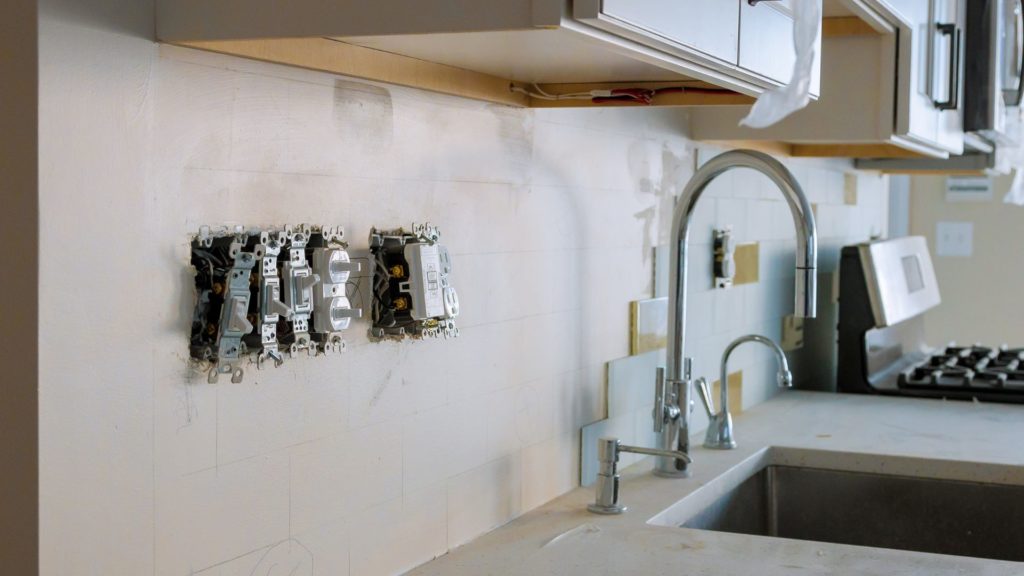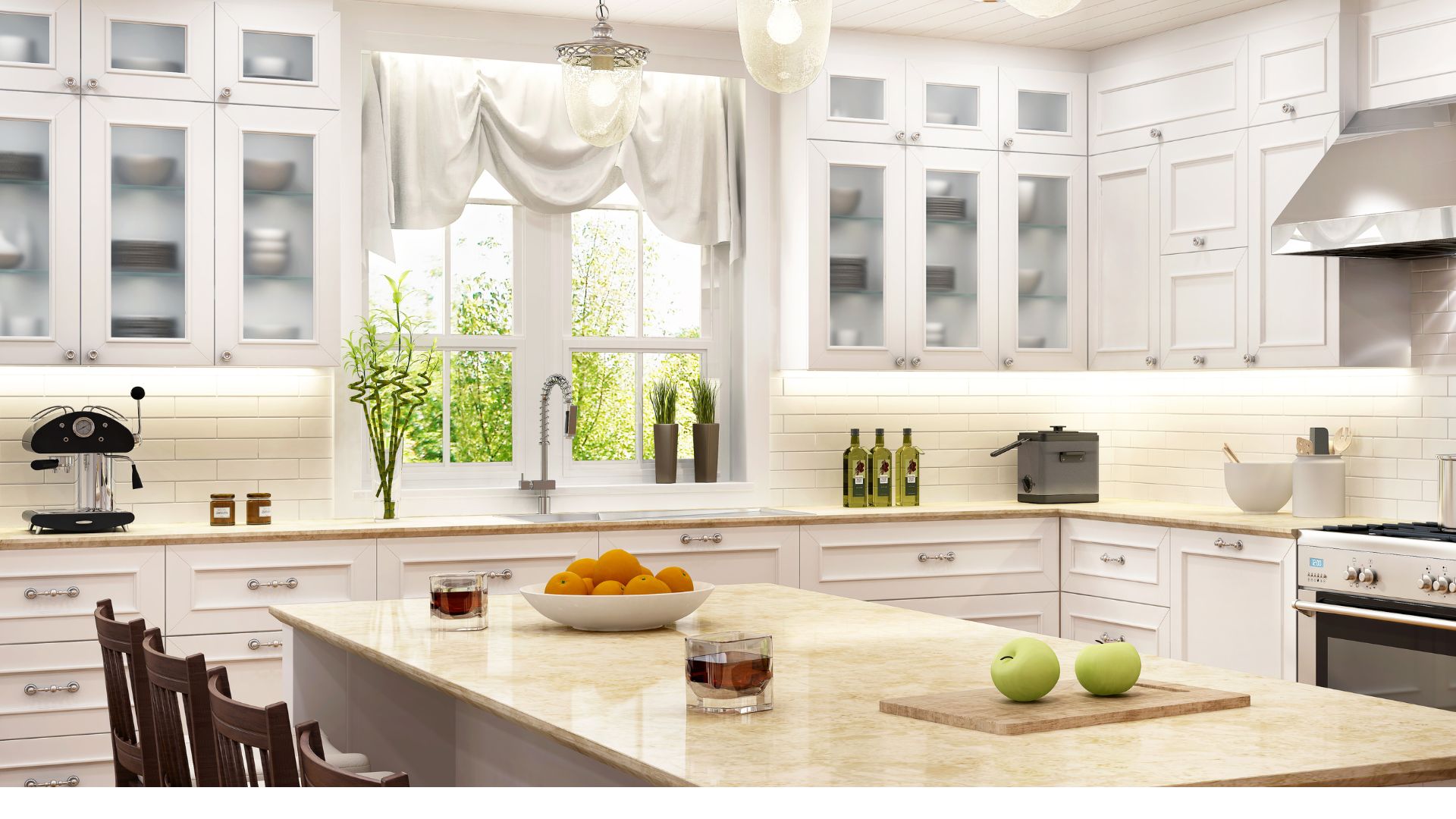Are you trying to remodel your kitchen? You are probably wondering where to place the outlets. Some people position these devices wherever they want, but is that acceptable? What does the law say? This guide will remove all the confusion.
How High Should Kitchen Outlets Be?
Where countertops are concerned, aim for 18-20 inches above the surface. You are free to place the outlets immediately above the countertop backsplash. If you’re more concerned about the distance from the ground, you should target 44 to 48 inches above the finished floor.
Average Height Of Kitchen Outlet
| Kitchen Outlet Height From Floor | 48 to 54 Inches |
| Kitchen Outlet Height Above Countertop | 18 to 20 Inches |
| ADA Kitchen Outlet Height | 44 to 48 Inches |
But that is only accurate for homes occupied by able-bodied individuals.
What about handicapped homeowners? The current height standards are supposed to simplify access to a socket for the average individual. But you cannot apply those standards to disabled people
This is why the information The Spruce has provided is so important. They want outlet boxes to sit 12 inches above the floor. Their measurements consider the distance between the box’s bottom and the floor’s top.
But if you want to cater to the needs of the disabled, you should install these outlets 15 inches from the floor. This standard is just as beneficial for the elderly.
You can keep the countertop outlet 15 or 20 inches above the countertop. Where possible, try to install the outlets at the same height. Not only are the outlets easier to install, but they are more visually appealing.
However, uniformity is not always an option. In fact, sometimes, obstacles in the setting can force you to ignore the standard height requirements. For example, if a particular surface is too brittle or delicate to add studs, you may have to install the outlet a little higher or lower than the standard demands.
But you have some wiggle room. No one expects you to remain within the ranges detailed above. Apply common sense. Better yet, talk to an expert. At the very least, they have tools that can accurately measure the distances.
Although, you don’t need a professional contractor to install outlets at the right height. A hammer is more than adequate. The average 16-ounce hammer has a length of 13 inches. You can use this tool to measure the 12 inches above the ground that a standard receptacle requires.
You can also use a laser level to mark the right spots. Then again, if you’ve never even heard of a laser level, you are better off leaving this work to a professional.
Things To Consider Before Wiring Kitchen Outlets
The position of the kitchen outlet is not a gamble. You have to follow certain rules to keep professional contractors happy, including:
1). First of all, you have to arm the kitchen with at least two 20-amp circuits. It is also common practice to place an outlet within 6 inches of every work area. These rules apply to the laundry room as well.
2). You should add GFCI technology to any outlets in damp areas.
3). Every point in the kitchen (along the floor line) should be no more than six feet away from an outlet.
4). Every wall counter 12 inches or broader needs an outlet.
5). Make sure that every point along the wall line is less than 24 inches away from a receptacle outlet. The goal is to make the outlets as accessible as possible from every point in the kitchen.
6). Every peninsular counter space (at least 12 inches wide and 24 inches deep) requires a minimum of one receptacle.
7). What kind of peninsular counter do you have? Does it have a flat top across the surface? If it doesn’t, and you have backsplashes, dividers, and the like, you must install the outlet above the counter.
8). You can place the receptacle below (no more than 12 inches down) the peninsular counter if it has a flat top across the whole surface.
As you can see, finding the appropriate height and position for an outlet is not easy. You have to take a multitude of considerations into account. This is why consumers leave decisions of this sort to contractors.
What Is The Code For Kitchen Outlets?
The NEC is not as concerned about the height of an electrical outlet as you might expect. To be more specific, they don’t care about the distance between the floor and the outlet.
Their regulations are more interested in the position of the outlets above or below the countertop. For instance, you have to position the outlets in such a way that every point on the counter is no more than two feet away from the outlet.
The objective is to ensure that a kitchen appliance’s power cord can reach the receptacle whenever needed. If you want to place the outlet inside a cabinet, it must be less than 12 inches below.
As far as the height of the outlets above the counter is concerned, don’t exceed 12 inches. If you want to add a light switch instead of a socket, keep it 4 inches above the countertop.
But again, you don’t have to worry about the distance between the outlet and the floor. Many contractors will keep the outlets at 48 inches from the floor. But this is the standard. It is not a law.
You can also install the outlets on the countertop. Although, you have to check with the outlet’s manufacturer. Some receptacles are not suitable for a countertop installation.
Keep the ‘Americans with Disabilities Act’ in mind. It will influence the height of the outlets. You should also check with your local authorities to determine whether or not they have any regulations for you to follow. Don’t expect every region to use the NEC’s rules.
Where Should Outlets Be Placed In A Kitchen?
I want you to look at your electrical needs. Where do you plan to position your appliances? Can you move your kitchen equipment, or is it stuck in place? You must install the outlets within the vicinity of the appliances they will operate. Additionally, I want you to ensure that all the spaces on the counter are within 24 inches of an outlet.
Don’t forget all the other relevant standards and practices, including:
- Keeping the outlets above a continuous countertop 48 inches apart
- Adding outlets to serve every countertop with a width of at least 12 inches
- Adding at least one outlet to serve the countertops of islands and peninsulas and restricting the distance to a maximum of 12 inches below.
You should also remember the basic considerations, such as restricting the minimum height of an outlet above a countertop to 15 inches and the maximum height to 20 inches.
Types of Outlets That Should Be Used In A Kitchen?
A kitchen requires two 20A 120V circuits. Therefore, you need 20A outlets. 20A outlets run most of the appliances you find in a kitchen. In truth, a 20A outlet can operate most devices in your home.
However, kitchens are unique because they have sinks and washers. As such, you have to install GFCI outlets. They trip when a ground fault occurs, switching the power off.

GFCI outlets protect homeowners and their equipment from electrocution and unexpected fires. These are the only outlet types you require in a kitchen.
You can experiment with AFCI outlets if they are necessary. Unlike GFCIs, which respond to ground faults, AFCIs provide a defense against arcing. However, you can make do without them.
How Many Outlets Are Required In A Kitchen?
You have to install at least two outlets (20A 120V) in the kitchen. There is no maximum limit. You can add as many receptacles as you want.
Related post:
- Standard Bathroom Outlet Height(With Examples)
- Garage Outlet Height And Spacing[With 7 Examples]
- What Is The Standard Height For A Refrigerator Outlet?
How Far Apart Should Outlets Be Spaced In A Kitchen?
You must ensure that every point in a room is within 6 inches of an outlet. You can apply that rule to your kitchen to identify the appropriate distance between receptacles.
Additionally, every point on the countertop should be within 24 inches (maximum) of an outlet.
You could follow the rule that wants contractors to keep outlets 48 inches apart. But many local authorities do not directly regulate the distance between kitchen outlets.
Are All Kitchen Outlets The Same Height?
You don’t have to make kitchen outlets the same height. But it is more convenient.

